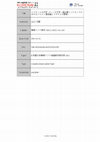Papers by Motoki Yamaguchi
Die Welt des Islams, Apr 2, 2024
PPIM UIN Jakarta, 2016
399-632 pg.; 23 cm

Jawi, the Arabic script of the Malay language, is one of the cultural components historically sha... more Jawi, the Arabic script of the Malay language, is one of the cultural components historically shared in the Malay-Islamic world. Indonesia experienced a shift to the Roman alphabet during the early twentieth century, before Malaya did. However, in the 1950s, immediately after Indonesia's independence, Islamic leaders from West Sumatra initiated a discourse to revive the use of Jawi. This article examines the background of the discourse as well as its relationship to Malaya. Two factors can be identified as forming this background. First, Indonesian Islamic forces demanded the Islamization of the state and society. The discourse on Jawi was related to the emphasis on the significance of Islam in Indonesian culture. Second, regional dissatisfaction was heightened with the predominance of Java, the center of the state. As Jawi is called "the script of Malay" in Indonesia, the revivalist discourse can be understood as demanding respect for the regional Malay culture. From ...
東南アジア研究(Japanese Journal of Southeast Asian Studies)58/2, 2021
Jawi, the Arabic script of the Malay language, is one of the cultural components historically sha... more Jawi, the Arabic script of the Malay language, is one of the cultural components historically shared in the Malay-Islamic world. Indonesia experienced a shift to the Roman alphabet during the early twentieth century, before Malaya did. However, in the 1950s, immediately after Indonesia's independence, Islamic leaders from West Sumatra initiated a discourse to revive the use of Jawi. This article examines the background of the discourse as well as its relationship to Malaya.
HIROSUE Masashi(ed.), A History of the Social Integration of Visitors, Migrants, and Colonizers in Southeast Asia (Toyo Bunko Research Library 21), 2020

史苑, 2019
Among the technologies that developed in the modern West, print promoted communication on a gl... more Among the technologies that developed in the modern West, print promoted communication on a global scale. In the Muslim world, some Arabic-language periodicals of the Arab region acquired wide readership, even in Southeast Asia. Among those periodicals read in Southeast Asia, previous studies have examined al-Manār (1898–1940), a famous Islamic reformist journal published in Cairo, almost exclusively. They have overlooked, however, the influx of many other periodicals of the Arab region into Southeast Asia. This article deals with a Cairene Islamic journal, al-Fatḥ (1926–1948), which was published by Muḥibb al-Dīn al-Khaṭīb. It examines its contributors and other information sources on the Southeast Asian side, comparing them with al-Manār. This article elucidates Southeast Asians who acted as mediators between the two regions in the network formed by periodicals of the Arab region.
Al-Fatḥ published about 200 articles relating to Southeast Asia, even more than those of al-Manār. As for the contributors and information sources on the Southeast Asian side, we can point out two things; first, just like al-Manār, two groups of Southeast Asians became deeply involved with this journal, that is to say, Southeast Asian Arabs and indigenous Muslims who studied or had studied in the Arab region, such as Makkah and Cairo. The numbers of both groups increased due to the widespread availability of steamships, another technological development of the modern era, in Indian Ocean traffic. Second, we find few contributions from leading figures among Southeast Asian indigenous Muslims in al-Fatḥ as well as in al-Manār. Thus, it is suggested that, within the Southeast Asian Muslim community, leading indigenous figures dedicated themselves to internal affairs, while Arabs and some indigenous Muslims who stayed or had stayed in the Arab region played specific roles mediating between the two regions.
Memoirs of the Research Department of the Toyo Bunko, 2017
Al-Irshad is an organization established by Arabs living in Indonesia in 1914. This article inves... more Al-Irshad is an organization established by Arabs living in Indonesia in 1914. This article investigates how the activities of al-Irshad changed from the late Dutch colonial period to the 1950s. Its objective is to elucidate how the Arabs were integrated in Indonesian society and what key factors were involved in this process.
Genre Journal Article URL
Bulletin of the Society for Near Eastern Studies in Japan, 2006
Die Welt des Islams -- ToC by Motoki Yamaguchi
https://brill.com/view/journals/wdi/64/4/wdi.64.issue-4.xml











Uploads
Papers by Motoki Yamaguchi
Al-Fatḥ published about 200 articles relating to Southeast Asia, even more than those of al-Manār. As for the contributors and information sources on the Southeast Asian side, we can point out two things; first, just like al-Manār, two groups of Southeast Asians became deeply involved with this journal, that is to say, Southeast Asian Arabs and indigenous Muslims who studied or had studied in the Arab region, such as Makkah and Cairo. The numbers of both groups increased due to the widespread availability of steamships, another technological development of the modern era, in Indian Ocean traffic. Second, we find few contributions from leading figures among Southeast Asian indigenous Muslims in al-Fatḥ as well as in al-Manār. Thus, it is suggested that, within the Southeast Asian Muslim community, leading indigenous figures dedicated themselves to internal affairs, while Arabs and some indigenous Muslims who stayed or had stayed in the Arab region played specific roles mediating between the two regions.
Die Welt des Islams -- ToC by Motoki Yamaguchi
Al-Fatḥ published about 200 articles relating to Southeast Asia, even more than those of al-Manār. As for the contributors and information sources on the Southeast Asian side, we can point out two things; first, just like al-Manār, two groups of Southeast Asians became deeply involved with this journal, that is to say, Southeast Asian Arabs and indigenous Muslims who studied or had studied in the Arab region, such as Makkah and Cairo. The numbers of both groups increased due to the widespread availability of steamships, another technological development of the modern era, in Indian Ocean traffic. Second, we find few contributions from leading figures among Southeast Asian indigenous Muslims in al-Fatḥ as well as in al-Manār. Thus, it is suggested that, within the Southeast Asian Muslim community, leading indigenous figures dedicated themselves to internal affairs, while Arabs and some indigenous Muslims who stayed or had stayed in the Arab region played specific roles mediating between the two regions.